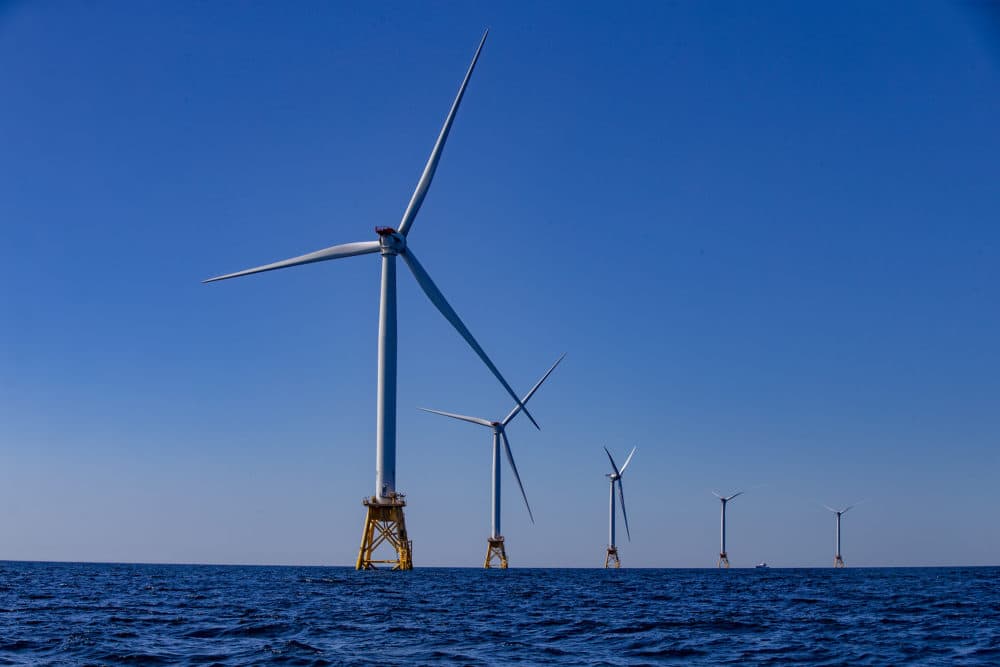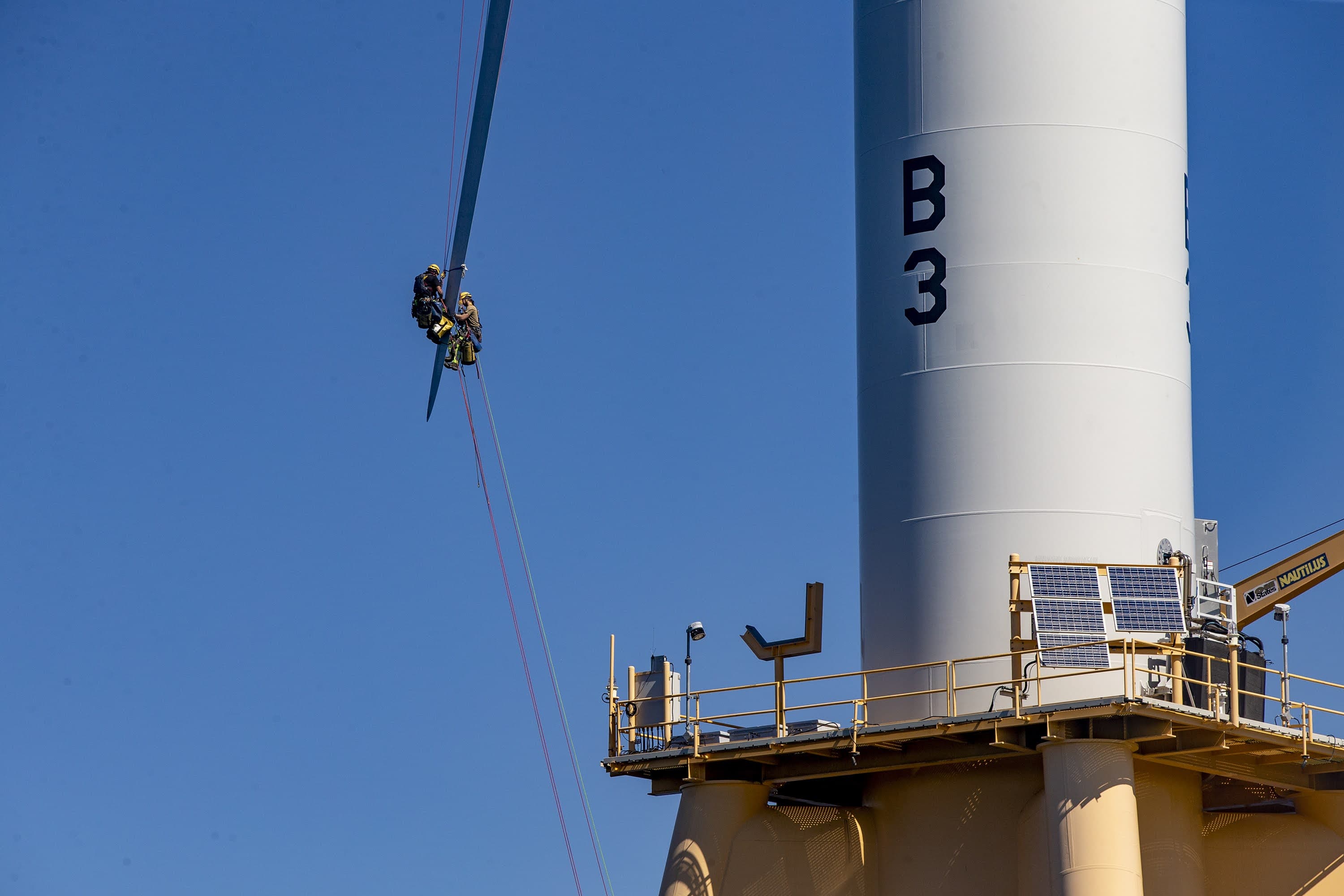Advertisement
A wind project promised Mass. cheap power. Then came inflation

Update: On Dec. 16, Avangrid told the state's Department of Public Utilities that it will pull out of its contracts for the Commonwealth Wind project. The company says it plans to file a new bid this spring when the state opens another round of offshore wind solicitations.
There’s more drama in the ongoing saga with Massachusetts’ largest approved offshore wind project, Commonwealth Wind.
Months after its developer, Avangrid, signed power contracts with three major utilities, the company is trying to get the state’s Department of Public Utilities to allow it to renegotiate those agreements. The company says supply constraints and rising interest rates require that they charge more for their wind power if the project has a chance of being viable.
Earlier this month, the DPU said no, but that didn't stop Avangrid from asking again.
Late Monday night, the offshore wind developer reiterated that its 1,200 megawatt project will only be financially viable if the company is allowed to charge more for the electricity it produces.
If you’re confused, you’re not alone. This is a very strange and complicated situation that raises some serious questions about the future of offshore wind in the region and Massachusetts’ ability to meet its 2030 clean energy targets.
Here’s what you need to know.
What is this all about?
Massachusetts has ambitious offshore wind goals and periodically holds competitive auctions to lock in projects. The state says how much wind electricity it’s looking to get, and then wind developers submit bids. In their bids, companies say what they’ll charge for electricity. They also outline other economic development benefits their project can provide — things like manufacturing facilities and job training programs.
After reviewing the options, the state chooses one or more projects, and tells the major utilities to sign long-term electricity contracts called “power purchase agreements.”
So far, Massachusetts has held three solicitations and selected four projects capable of producing a total of 3,200 megawatts — approximately enough electricity to power 1.6 million homes in the state.
Last December, during the most recent solicitation, the state chose the 1,200-megawatt Commonwealth Wind project, along with a 400-megawatt project from developer Mayflower Wind. The bids for both projects promised cheaper electricity for consumers than either of the previous two projects under development in the state, and were celebrated at the time as a major milestone for the state’s ability to produce carbon-free power and save ratepayers money.
Advertisement
But fast forward to today, and Avangrid is having second thoughts about the price of the electricity it promised to sell.

So what’s going on with Commonwealth Wind?
This past spring, three big utilities in Massachusetts — Eversource, National Grid and Unitil — signed power contracts with Avangrid and Mayflower, and submitted them to the Department of Public Utilities for review.
As the review was going on, the global economic situation continued to deteriorate and Avangrid started to get nervous about its ability to finance the project.
In September, Avangrid pushed back Commonwealth Wind’s start date from 2027 to 2028 and said it wanted to renegotiate its power contracts. And then on Oct. 20, it officially asked the DPU to pause its review of the power contracts for one month so that the company could attempt to renegotiate the sale price of its electricity.
In its filing, Avangrid wrote that absent changes to the contract, the Commonwealth Wind project “would not be able to move forward.”
In other words, the company said it would need ratepayers in the state to pay more for power to make the project work.
A week later, Mayflower Wind, the developer with the 400-megawatt project also under review, said it supported a pause for the same reasons.
“A one month suspension would enable the parties to consider potential approaches to help ensure these offshore wind projects are economic and financeable,” the company wrote.
But the utilities, it turns out, weren’t interested in renegotiating. And a few days later, the DPU weighed in, admonishing the companies for even asking to re-do the contracts so late in the game.
The DPU told the companies that they either had to commit to the power purchase agreements or pull out completely.
Mayflower quickly responded and said it would honor the current contract. Avangrid, at the last minute before the Monday night deadline, chose not to cancel the project, but made a point of saying that it simply wasn’t going to be able to make the numbers work with the current contract. And it requested that the DPU reconsider its previous request to renegotiate.
Avangrid has not publicly said what it wants to charge in a renegotiated contract, but in a recent interview with Commonwealth Magazine, the company’s vice president for offshore wind development, Ken Kimmell, said making the project viable would only require a “very modest increase.” He added that the company was confident it could charge less than some other projects in the state, allowing it to remain one of the cheapest offshore wind farms in the country.
According to the state, all of the offshore projects it’s so far approved will save ratepayers money.
So what happens now?
It remains to be seen how the DPU responds, though if recent history is any indication, it will not look favorably on this request. It’s also unclear whether the utilities will change their minds on price negotiation.
At the state level, the Baker administration says it recognizes the economic challenges facing the offshore wind industry and wants to help Avangrid and all offshore wind developers in the state “take advantage of” the various state and federal incentives for offshore wind development.
And Attorney General Maura Healey, who will take office as the new governor of Massachusetts in January, also wants the Commonwealth Wind project to move forward, according to her spokeswoman. She added that the office is “reviewing project financials and will work collaboratively to explore options to improve project economics for all parties.”
What does this mean for offshore wind?
Is this simply a disagreement between a private energy company and state regulators over the terms of a power contract, or does the situation cast doubt on the viability of offshore wind? That is the billion dollar question.
To Dennis Wamsted, energy analyst at the Institute for Energy Economics and Financial Analysis, it’s the former. He says this is a situation where a company signed a contract at a time of far less economic turmoil, and now it’s questioning that decision.
The last year has seen growing supply chain disruptions, increases in the price of steel, and rising interest rates, “and the company says, ‘Well, this is not nearly as economic as we thought it was going to be,’ ” he says.
This is a big issue for Avangrid, he adds, “but to me, that's a one-off kind of problem. It's not an indictment on offshore wind.”
John Rogers, a senior energy analyst at the Union of Concerned Scientists agrees: “I think it's clear that we're in a very unusual time, in terms of supply chain issues, inflation across the economy,” he says. “But the first large-scale offshore wind project just started construction, and I think just seeing these things in the water is really going to change how people understand and feel about the technology, and it's going to have nothing but momentum behind it.”
Others are less optimistic. A recent E&E News story cites energy experts who believe the current economic situation could cause the country to fall short of the Biden Administration’s goal of 30 gigawatts by 2030.
But, by all accounts, the country — and Massachusetts — is moving forward with offshore wind, even as some of the first projects face challenges.
“We're not seeing offshore wind failing. We're seeing some economic turmoil and corporations trying to address the uncertainty by finding additional value for themselves,” says Melissa Birchard, director of the Acadia Center’s Clean Energy & Grid Transition program.
“Should they be allowed to get that value from renegotiating? That's a question that's on the table right now, but it certainly doesn't speak to the viability of this entire industry.”
This article was originally published on November 16, 2022.
